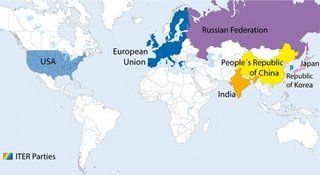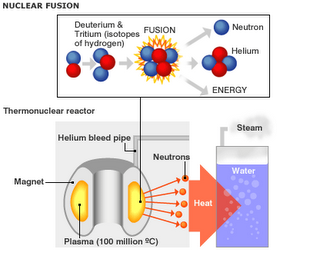Nuclear conFusion
 ITER is a joint international research and development project that aims to demonstrate the scientific and technical feasibility of fusion power. The idea for ITER originated from the Geneva superpower summit in November 1985 where Premier Gorbachev, following discussions with President Mitterand of France, proposed to President Reagan that an international project be set up to develop fusion energy for peaceful purposes.
ITER is a joint international research and development project that aims to demonstrate the scientific and technical feasibility of fusion power. The idea for ITER originated from the Geneva superpower summit in November 1985 where Premier Gorbachev, following discussions with President Mitterand of France, proposed to President Reagan that an international project be set up to develop fusion energy for peaceful purposes.Many who are opposed to nuclear fission hold out hope that fusion will make good on nuclear energy's promise as a safe and unlimited source of energy. However, a number of environmentalists remain unconvinced, believing that the benefits of fusion have been overblown and its problems understated. (GW)
States sign nuclear energy pact
BBC News
November 21, 2006
An international consortium has signed a formal agreement to build an experimental nuclear fusion reactor.
The multi-billion-euro project known as Iter - or "the way" in Latin - will aim to produce energy from nuclear reactions like those that fuel the Sun.
If successful, it could provide energy that is clean and almost limitless.
The project, which will be based in France, follows years of talks between South Korea, Russia, China, the EU, the US, India and Japan.
If all goes well, officials will build a demonstration power plant before rolling out the technology to the world. Iter says electricity could be available on the grid within 30 years.
Big reward
"Fusion could become the dominant source of electricity on Earth in a century or so - we have to work to try to get it," Jerome Pamela of Iter told the BBC.
In a fusion reaction, energy is released when light atomic nuclei - the hydrogen isotopes deuterium and tritium - are fused together to form heavier atomic nuclei.
To use controlled fusion reactions on Earth as an energy source, it is necessary to heat a gas to temperatures exceeding 100 million Celsius - many times hotter than the centre of the Sun.
One of the attractions of fusion is the tiny amount of fuel needed. The release of energy from a fusion reaction is said to be 10 million times greater than from a typical chemical reaction, such as burning a fossil fuel.
Lead partner
The project is based in Cadarache, about 60km (40 miles) from Marseille in the Provence-Alpes-Cote d'Azur region. It currently hosts Tore-Supra, one of the existing European centres for fusion research.
Work to clear a wooded area for the Iter buildings will begin in the spring. Ancillary and power facilities and a visitors' centre will go up in 2008. The reactor itself will start to take shape in 2009.
The French site was chosen after a long period of bartering between the Iter parties; and the EU, as the host bloc, is shouldering 50% of the five-billion-euro construction costs.
The deal signed by ministers on Tuesday puts those negotiations into effect, establishing the international organisation that will implement the Iter fusion energy project.
The signature took place at a ceremony at the Elysee Palace in Paris, hosted by the president of France, Jacques Chirac, and by the president of the European Commission, Jose Manuel Durao Barroso.
After the signature ceremony, the first meeting of the Interim Iter Council will take place.
The green lobby is opposed to the Iter project. It believes the benefits have been oversold and the difficulties and waste production issues underplayed.
Roger Higman, policy coordinator for Friends of the Earth, told BBC News: "We face a very real energy crisis over the next 50 years which is to do with climate change; that we have to stop using coal, oil and gas.
"The question we would ask is: isn't the money that's being spent on fusion better spent on proven technologies rather than chasing a dream that even its proponents say will take a hundred years before it's going to providing any of our energy answers?"
- The proposed Iter reactor is shaped like a doughnut - a Russian-conceived design referred to as a tokomak
- Deuterium and tritium - isotopes of hydrogen - are fed into the reactor and heated to 100 million Celsius
- A powerful magnetic field holds the hot plasma, or gas, away from the walls and squeezes to initiate fusion
- Iter hopes to do this in bursts of 500 seconds; a commercial reactor would have to run for prolonged periods
- In a commercial reactor, energetic neutrons are absorbed in a surrounding 'blanket' to drive a steam-turbine system
Thr photograph of the torus at the top of the page is courtesy of EFDA-JET.



0 Comments:
Post a Comment
<< Home